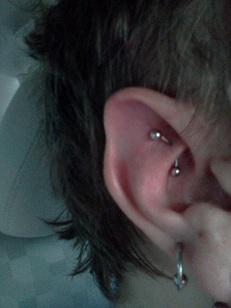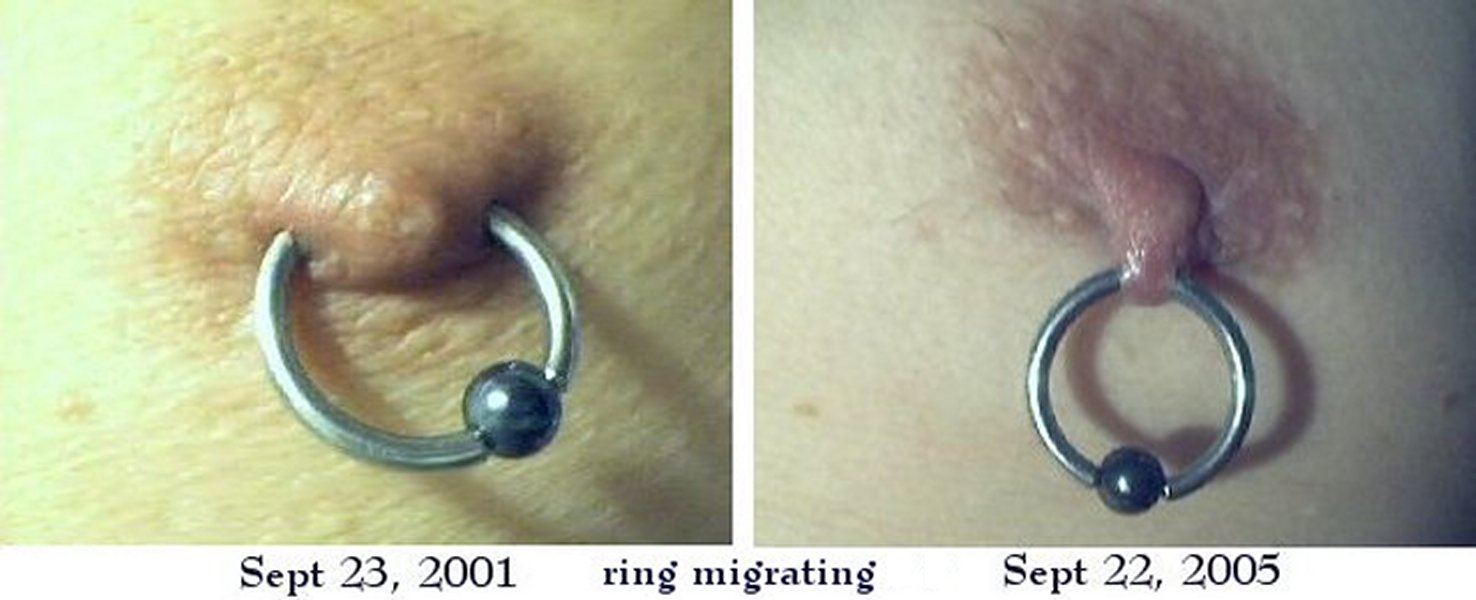|
Rook Piercing
A rook piercing is a perforation of the antihelix of the ear for the purpose of wearing jewelry. It is located just above the tragus on the ridge between the inner and outer conch with the piercing passing from the underside to the top of this ridge, differing from many ear piercings that essentially span between a "front" and "back" surface. Erik Dakota, a well known professional piercer and the individual responsible for originating and popularizing the rook piercing, is said to have named this modification after a shortened version of his first name. The piercing was first named in issue #4 of the magazine ''Body Play and Modern Primitives Quarterly'' (published by Fakir Musafar) around 1992 alongside the first printed reference to the industrial piercing, then termed "industrial ear project". Procedure The procedure is done similarly to other piercings of the cartilage of the ear. Clamps may be used but it is usually done freehand. Once the area is cleaned, the piercer ... [...More Info...] [...Related Items...] OR: [Wikipedia] [Google] [Baidu] |
Antihelix
The antihelix (anthelix) is a part of the visible ear; the pinna. The antihelix is a curved prominence of cartilage parallel with and in front of the helix on the pinna. The antihelix divides above into two ''legs'' or crura; the ''crura antihelicis'', between which is a triangular depression, the ''fossa triangularis''. Additional images File:Gray906.png, The muscles of the auricula. File:Earcov.JPG, Left human ear An ear is the organ that enables hearing and, in mammals, body balance using the vestibular system. In mammals, the ear is usually described as having three parts—the outer ear, the middle ear and the inner ear. The outer ear consists of ... File:Slide2COR.JPG, External ear. Right auricle. Lateral view. File:Slide3COR.JPG, External ear. Right auricle. Lateral view. File:Slide4COR.JPG, External ear. Right auricle. Lateral view. External links * () (#5) Auditory system {{anatomy-stub ... [...More Info...] [...Related Items...] OR: [Wikipedia] [Google] [Baidu] |
Infection
An infection is the invasion of tissues by pathogens, their multiplication, and the reaction of host tissues to the infectious agent and the toxins they produce. An infectious disease, also known as a transmissible disease or communicable disease, is an illness resulting from an infection. Infections can be caused by a wide range of pathogens, most prominently bacteria and viruses. Hosts can fight infections using their immune system. Mammalian hosts react to infections with an innate response, often involving inflammation, followed by an adaptive response. Specific medications used to treat infections include antibiotics, antivirals, antifungals, antiprotozoals, and antihelminthics. Infectious diseases resulted in 9.2 million deaths in 2013 (about 17% of all deaths). The branch of medicine that focuses on infections is referred to as infectious disease. Types Infections are caused by infectious agents (pathogens) including: * Bacteria (e.g. ''Mycobacterium tuberculosis'', ... [...More Info...] [...Related Items...] OR: [Wikipedia] [Google] [Baidu] |
Piercing Migration
Piercing migration is the process that occurs when a body piercing moves from its initial location. This process can be painful or go unnoticed, until it has progressed. Given enough time, a ring may migrate entirely outside of the skin, although it may only migrate a small amount and come to rest. Potential causes and effects of migration The effects of migration can vary widely. The most common form of migration is the way that heavy small gauge earrings will migrate downwards out of the earlobe, as is common in older women who have worn earrings most of their lives. This is known as the "cheesecutter effect", as its action is easily compared to the method of cutting cheese with a fine wire. Contemporary body and ear piercing jewelry is much more balanced in its weight to gauge ratio, although migration is still possible with heavy jewelry, even if it is of large gauge. Play or movement of the area pierced or implanted can also lead to migration, but it's not likely. Sometimes ... [...More Info...] [...Related Items...] OR: [Wikipedia] [Google] [Baidu] |
Barbell (piercing)
Barbell style piercing jewelry is composed of a straight bar with a bead on each end, one or both beads unscrewable for removal and/or changing of the beads. Often one of the beads is fixed, either via epoxy or welding, so that only one bead is used to install or remove the jewelry. Barbell threads are usually right-handed. They are named because they resemble the barbells that are used in weightlifting. Types of barbells Internally threaded barbells Named because the bar has smooth ends with receiving threads tapped into the end of the bar. In internally threaded jewelry, the bead has a receiving tube machined into it (this is referred to as "countersunk"), with a threaded post extending from the center, which mates with the threaded receiving tube on the bar. Being much less likely to cause damage and irritation, especially at the time of piercing, internally threaded jewelry is considered superior to externally threaded jewelry. It is usually slightly more expe ... [...More Info...] [...Related Items...] OR: [Wikipedia] [Google] [Baidu] |
Captive Bead Ring
A captive bead ring (CBR), ball closure ring (BCR), captive hoop, or captive ball ring is a common example of body piercing jewelry. The captive bead or ball fits into a small opening in the circle of the ring. The bead is slightly larger than this opening and has small indentations or depressions that correspond to the ring's end-points so that it may fit snugly against them, thus completing the circuit of the ring. Often, a hole is drilled through the bead to allow easier fitting. It uses the natural tensile or compressive strength of the metal the ring is made of, usually surgical stainless steel, niobium, or titanium, to hold the bead tightly in place. The bead or ball itself may additionally be made from coloured glass, acrylic or ceramic, or a gemstone. This is a popular piece of body jewelry because it conveniently allows the wearer to remove the ring by simply removing the captive bead, the bead is held firmly in place so that it will not easily fall out. Additionally, ... [...More Info...] [...Related Items...] OR: [Wikipedia] [Google] [Baidu] |
Fistula
A fistula (plural: fistulas or fistulae ; from Latin ''fistula'', "tube, pipe") in anatomy is an abnormal connection between two hollow spaces (technically, two epithelialized surfaces), such as blood vessels, intestines, or other hollow organs. Types of fistula can be described by their location. Anal fistulas connect between the anal canal and the perianal skin. Anovaginal or rectovaginal fistulas occur when a hole develops between the anus or rectum and the vagina. Colovaginal fistulas occur between the colon and the vagina. Urinary tract fistulas are abnormal openings within the urinary tract or an abnormal connection between the urinary tract and another organ such as between the bladder and the uterus in a vesicouterine fistula, between the bladder and the vagina in a vesicovaginal fistula, and between the urethra and the vagina in urethrovaginal fistula. When occurring between two parts of the intestine, it is known as an enteroenteral fistula, between the small intest ... [...More Info...] [...Related Items...] OR: [Wikipedia] [Google] [Baidu] |
Hydrogen Peroxide
Hydrogen peroxide is a chemical compound with the formula . In its pure form, it is a very pale blue liquid that is slightly more viscous than water. It is used as an oxidizer, bleaching agent, and antiseptic, usually as a dilute solution (3%–6% by weight) in water for consumer use, and in higher concentrations for industrial use. Concentrated hydrogen peroxide, or " high-test peroxide", decomposes explosively when heated and has been used as a propellant in rocketry. Hydrogen peroxide is a reactive oxygen species and the simplest peroxide, a compound having an oxygen–oxygen single bond. It decomposes slowly when exposed to light, and rapidly in the presence of organic or reactive compounds. It is typically stored with a stabilizer in a weakly acidic solution in a dark bottle to block light. Hydrogen peroxide is found in biological systems including the human body. Enzymes that use or decompose hydrogen peroxide are classified as peroxidases. Properties The boiling poi ... [...More Info...] [...Related Items...] OR: [Wikipedia] [Google] [Baidu] |
Rubbing Alcohol
Rubbing alcohol is either an isopropyl alcohol or an ethanol-based liquid, with isopropyl alcohol products being the most widely available. The comparable ''British Pharmacopoeia'' (''BP'') is surgical spirit. Rubbing alcohol is denatured and undrinkable even if it is ethanol-based, due to the bitterants added. They are liquids used primarily as a topical antiseptic. They also have multiple industrial and household applications. The term "rubbing alcohol" in North American English is a general term for either isopropyl alcohol (isopropanol) or ethyl alcohol (ethanol) products. The ''United States Pharmacopeia'' (''USP'') defines "isopropyl rubbing alcohol USP" as containing approximately 70 percent alcohol by volume of pure isopropyl alcohol and defines "rubbing alcohol USP" as containing approximately 70 percent by volume of denatured alcohol. In Ireland and the UK, the comparable preparation is surgical spirit B.P., which the ''British Pharmacopoeia'' defines as 95% methylated ... [...More Info...] [...Related Items...] OR: [Wikipedia] [Google] [Baidu] |
Antibacterial Soap
Antibacterial soap is a soap which contains chemical ingredients that purportedly assist in killing bacteria. The majority of antibacterial soaps contain triclosan, though other chemical additives are also common. The effectiveness of products branded as being antibacterial has been disputed by some academics as well as the U.S. Food and Drug Administration (FDA). History The earliest antibacterial soap was carbolic soap, which used up to 5% phenols (carbolic acid). Fears about the safety of carbolic soaps chemical components on the skin brought about a ban on some of these chemical components. Triclosan and other antibacterial agents have long been used in commercial cleaning products for hospitals and other healthcare settings, however they began to be used in home cleaning products during the 1990s. Ingredients Triclosan and triclocarban are the most common compounds used as antibacterials in soaps. However, other common antibacterial ingredients in soaps include benzalkonium ... [...More Info...] [...Related Items...] OR: [Wikipedia] [Google] [Baidu] |
Antimicrobial
An antimicrobial is an agent that kills microorganisms or stops their growth. Antimicrobial medicines can be grouped according to the microorganisms they act primarily against. For example, antibiotics are used against bacteria, and antifungals are used against fungi. They can also be classified according to their function. Agents that kill microbes are microbicides, while those that merely inhibit their growth are called bacteriostatic agents. The use of antimicrobial medicines to treat infection is known as antimicrobial chemotherapy, while the use of antimicrobial medicines to prevent infection is known as antimicrobial prophylaxis. The main classes of antimicrobial agents are disinfectants (non-selective agents, such as bleach), which kill a wide range of microbes on non-living surfaces to prevent the spread of illness, antiseptics (which are applied to living tissue and help reduce infection during surgery), and antibiotics (which destroy microorganisms within the body). The ... [...More Info...] [...Related Items...] OR: [Wikipedia] [Google] [Baidu] |
Lymph
Lymph (from Latin, , meaning "water") is the fluid that flows through the lymphatic system, a system composed of lymph vessels (channels) and intervening lymph nodes whose function, like the venous system, is to return fluid from the tissues to be recirculated. At the origin of the fluid-return process, interstitial fluid—the fluid between the cells in all body tissues—enters the lymph capillaries. This lymphatic fluid is then transported via progressively larger lymphatic vessels through lymph nodes, where substances are removed by tissue lymphocytes and circulating lymphocytes are added to the fluid, before emptying ultimately into the right or the left subclavian vein, where it mixes with central venous blood. Because it is derived from interstitial fluid, with which blood and surrounding cells continually exchange substances, lymph undergoes continual change in composition. It is generally similar to blood plasma, which is the fluid component of blood. Lymph returns pro ... [...More Info...] [...Related Items...] OR: [Wikipedia] [Google] [Baidu] |







